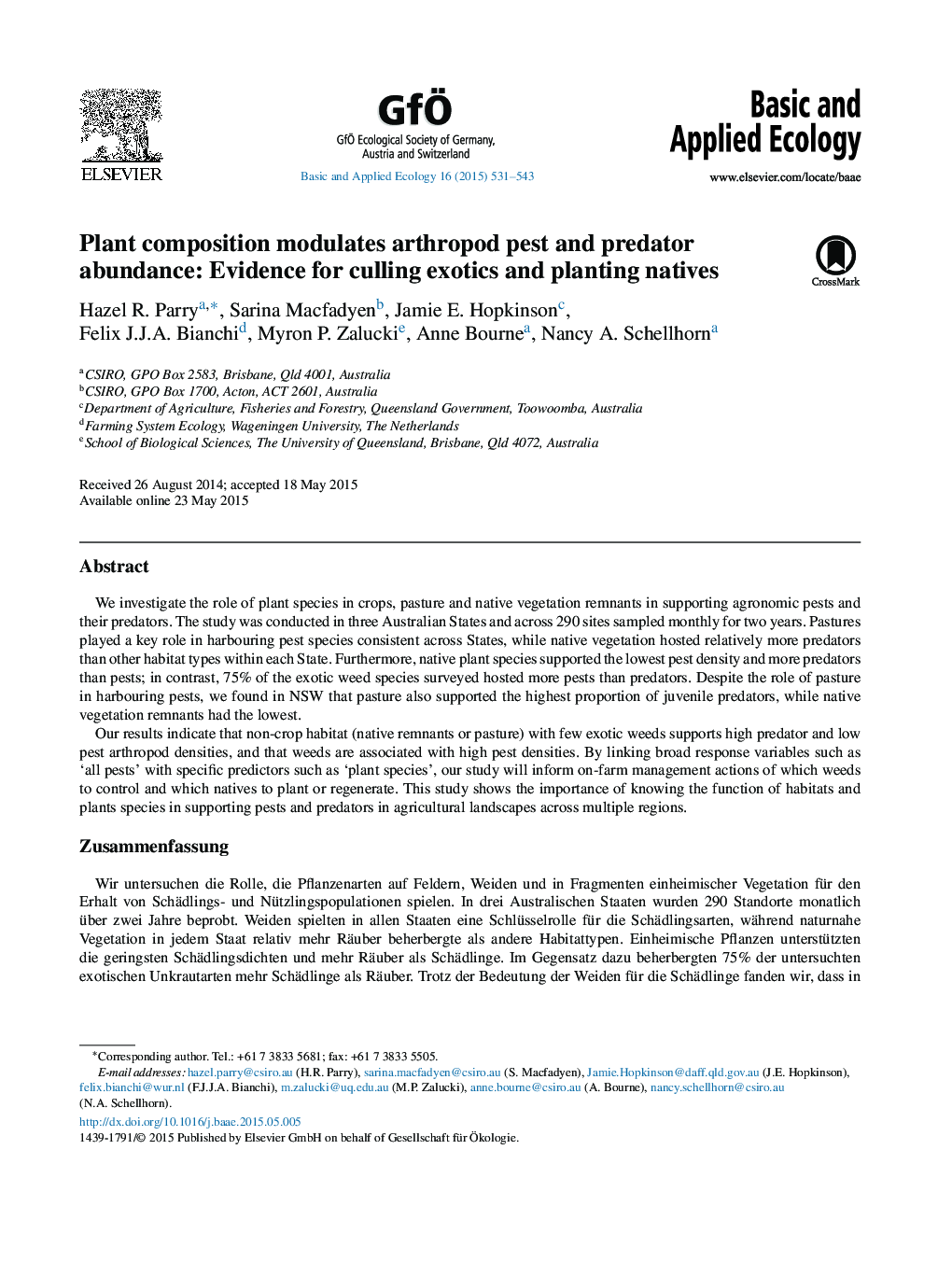| کد مقاله | کد نشریه | سال انتشار | مقاله انگلیسی | نسخه تمام متن |
|---|---|---|---|---|
| 4383885 | 1304372 | 2015 | 13 صفحه PDF | دانلود رایگان |
We investigate the role of plant species in crops, pasture and native vegetation remnants in supporting agronomic pests and their predators. The study was conducted in three Australian States and across 290 sites sampled monthly for two years. Pastures played a key role in harbouring pest species consistent across States, while native vegetation hosted relatively more predators than other habitat types within each State. Furthermore, native plant species supported the lowest pest density and more predators than pests; in contrast, 75% of the exotic weed species surveyed hosted more pests than predators. Despite the role of pasture in harbouring pests, we found in NSW that pasture also supported the highest proportion of juvenile predators, while native vegetation remnants had the lowest.Our results indicate that non-crop habitat (native remnants or pasture) with few exotic weeds supports high predator and low pest arthropod densities, and that weeds are associated with high pest densities. By linking broad response variables such as ‘all pests’ with specific predictors such as ‘plant species’, our study will inform on-farm management actions of which weeds to control and which natives to plant or regenerate. This study shows the importance of knowing the function of habitats and plants species in supporting pests and predators in agricultural landscapes across multiple regions.
ZusammenfassungWir untersuchen die Rolle, die Pflanzenarten auf Feldern, Weiden und in Fragmenten einheimischer Vegetation für den Erhalt von Schädlings- und Nützlingspopulationen spielen. In drei Australischen Staaten wurden 290 Standorte monatlich über zwei Jahre beprobt. Weiden spielten in allen Staaten eine Schlüsselrolle für die Schädlingsarten, während naturnahe Vegetation in jedem Staat relativ mehr Räuber beherbergte als andere Habitattypen. Einheimische Pflanzen unterstützten die geringsten Schädlingsdichten und mehr Räuber als Schädlinge. Im Gegensatz dazu beherbergten 75% der untersuchten exotischen Unkrautarten mehr Schädlinge als Räuber. Trotz der Bedeutung der Weiden für die Schädlinge fanden wir, dass in New South Wales Weiden auch den höchsten Anteil von juvenilen Räubern beherbergten, während dieser in Fragmenten einheimischer Vegetation am geringsten war. Unsere Ergebnisse zeigen, dass naturnahe Fragmente und Weiden mit wenigen exotischen Unkräutern hohe Räuber- und geringe Schädlingsdichten unterstützen und dass Unkräuter mit hohen Schädlingsdichten assoziiert sind. Indem grobe abhängige Variablen, wie z.B. “Alle Schädlinge” mit spezifischen unabhängigen Variablen, wie z.B. “Pflanzenart” verknüpft werden, beeinflusst unsere Untersuchung Managementmaßnahmen vor Ort, wie z.B. welche Unkräuter bekämpft und welche einheimischen Arten gepflanzt oder regeneriert werden sollten. Unsere Untersuchung zeigt, wie wichtig es ist, Kenntnisse von der Funktion von Habitaten und Pflanzenarten für die Förderung von Schädlingen und Räubern in der Agrarlandschaft zu besitzen.
Journal: Basic and Applied Ecology - Volume 16, Issue 6, September 2015, Pages 531–543
